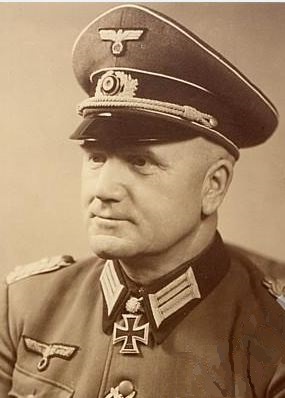Schröder, Wilhelm (Gren.Rgt. 580)
- Date of birth:
- July 7th, 1896 (Sommersell/Westphalia, Germany)
- Date of death:
- July 17th, 1979 (Witten a.d. Ruhr/Northrhine-Westphalia, Germany)
- Nationality:
- German
Biography
Besides the EK2 and EK1, Wilhelm Schröder also received the Lippisches Verdienstkreuz (November 1st, 1917), and the Schlesicher Adler 1. and 2. Klasse (October 28th, 1919) for his services prior to the Second World War.
Promotions:
July 1st, 1920: Wachtmeister (Schutzpolizei)
1920: Polizei-Leutnant
04.04.1928: Polizei-Oberleutnant
1935: Polizei-Hauptmann;
00.00.1936: Hauptmann - RDA 01.06.1934 (163b)
01.04.1940: Major (42)
01.04.1942: Oberstleutnant (479)
01.09.1944: Oberst (32)
Career:
August 19th, 1915: Rekrut Infanterie-Ersatz-Regiment 67;
?: Kommandeur, Grenadier-Regiment 580;
?: Kommandeur, Kampfgruppe Schröder.
Do you have more information about this person? Inform us!
- Period:
- First World War (1914-1918)
- Awarded on:
- August 16th, 1917
- Period:
- First World War (1914-1918)
- Awarded on:
- November 1st, 1917
- Period:
- First World War (1914-1918)
- Awarded on:
- June 17th, 1924
- Period:
- First World War (1914-1918)
- Awarded on:
- January 30th, 1935
- Period:
- Second World War (1939-1945)
- Awarded on:
- October 10th, 1939
Had already received the Iron Cross 2nd Class on August 16th, 1917.
- Period:
- Second World War (1939-1945)
- Awarded on:
- January 30th, 1943
- Period:
- Second World War (1939-1945)
- Awarded on:
- September 1st, 1943
- Period:
- Second World War (1939-1945)
- Awarded on:
- November 20th, 1943
Had already received the Iron Cross 1st Class on June 17th, 1924.
- Period:
- Second World War (1939-1945)
- Rank:
- Oberstleutnant (Lieutenant-colonel)
- Unit:
- Kommandeur, Grenadier-Regiment 580, 306. Infanterie-Division, Heer
- Awarded on:
- March 26th, 1944
- Period:
- Second World War (1939-1945)
- Rank:
- Oberst (Colonel)
- Unit:
- Kommandeur, Kampfgruppe Schröder, 408. Infanterie-Division, Heer
- Awarded on:
- March 13th, 1945
Awarded for his successes in commanding a regimental sized Kampfgruppe composed of men from the Heeresunteroffizierschule Striegau during February 1945 in the area around Parchwitz. Taking over leadership of the unit on 21.01.1945, the chronology of events leading to the award is as follows…
08.02. - The I. Bataillon of the Kampfgruppe is encircled in Jürtsch and the II. Bataillon is hard pressed in its battle at Merschwitz. With the last reserves Oberst Schröder cleans up the situation at Merschwitz, and the I. Bataillon succeeds in breaking out towards this town. Later on, when the regimental command post in Leschwitz came under attack from 15 enemy tanks with infantry support, Schröder and his staff are able to break the attack. 8 enemy tanks are destroyed, of which 5 were knocked out in close combat.
09.02. - The enemy strikes from Lüben towards Liegnitz, and in the process encircles Schröder’s regiment. The commander leads his Kampfgruppe through dense forest for 2 days and, on 11.02., is able to cross the the river near Arnsdorf and link up with the division once again.
11.02. - At around 14:00 the enemy launches a surprise attack from Liegnitz and Haynau against the regimental command post in Arnsdorf. Schröder personally leads a counterattack that clears the town of enemy forces. Later that evening the regiment receives orders to occupy the line Großnig—Fellendorf—Steubnitz—Panthenau. Steubnitz, which was already occupied by the enemy, is taken by storm and the regiment entrenches itself along the designated line.
13.02. - The regiment is ordered to occupy the line Bahnhof Wildschütz—Hohendorf—Bahnhof Kosendau. Towards the evening the regiment is encircled again. Schröder leads his regiment from the front and is able to break out across the road and railway line south of Rothkirch.
779th Award.
08.02. - The I. Bataillon of the Kampfgruppe is encircled in Jürtsch and the II. Bataillon is hard pressed in its battle at Merschwitz. With the last reserves Oberst Schröder cleans up the situation at Merschwitz, and the I. Bataillon succeeds in breaking out towards this town. Later on, when the regimental command post in Leschwitz came under attack from 15 enemy tanks with infantry support, Schröder and his staff are able to break the attack. 8 enemy tanks are destroyed, of which 5 were knocked out in close combat.
09.02. - The enemy strikes from Lüben towards Liegnitz, and in the process encircles Schröder’s regiment. The commander leads his Kampfgruppe through dense forest for 2 days and, on 11.02., is able to cross the the river near Arnsdorf and link up with the division once again.
11.02. - At around 14:00 the enemy launches a surprise attack from Liegnitz and Haynau against the regimental command post in Arnsdorf. Schröder personally leads a counterattack that clears the town of enemy forces. Later that evening the regiment receives orders to occupy the line Großnig—Fellendorf—Steubnitz—Panthenau. Steubnitz, which was already occupied by the enemy, is taken by storm and the regiment entrenches itself along the designated line.
13.02. - The regiment is ordered to occupy the line Bahnhof Wildschütz—Hohendorf—Bahnhof Kosendau. Towards the evening the regiment is encircled again. Schröder leads his regiment from the front and is able to break out across the road and railway line south of Rothkirch.
779th Award.

















